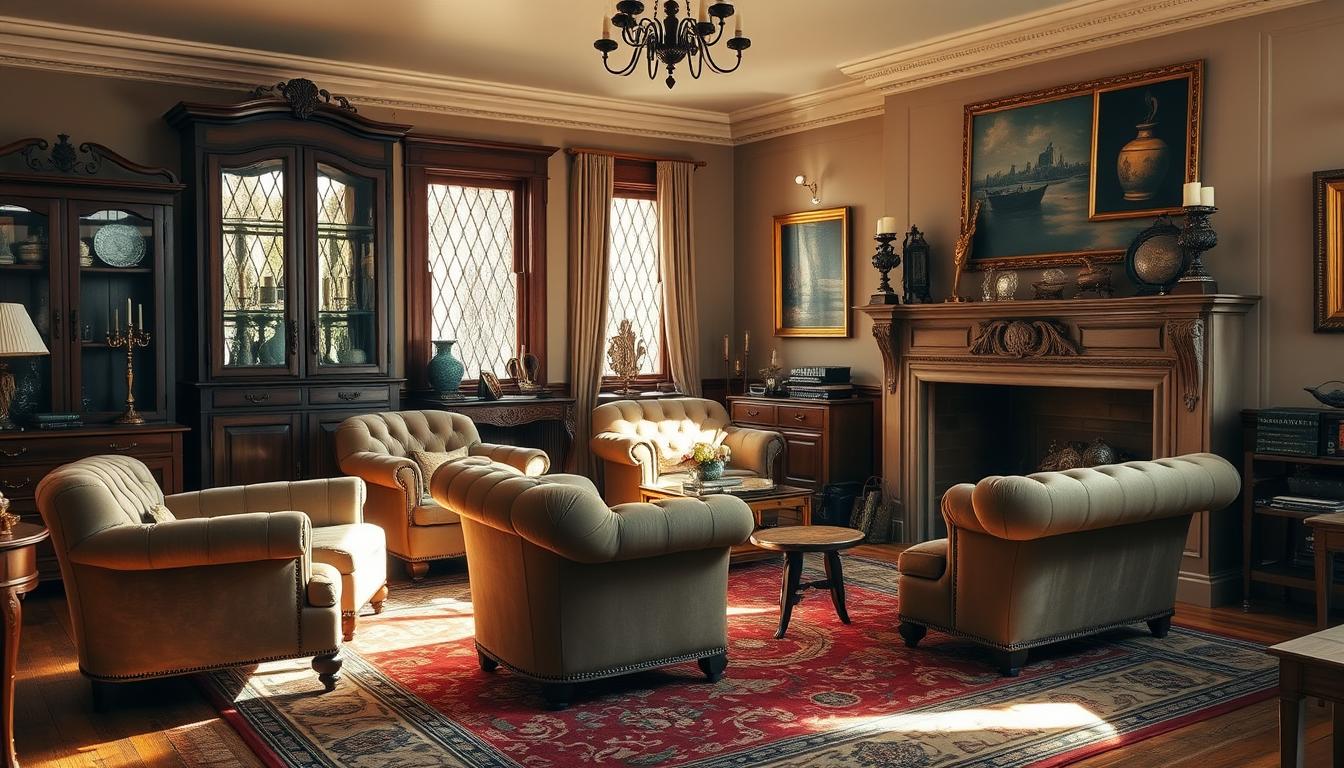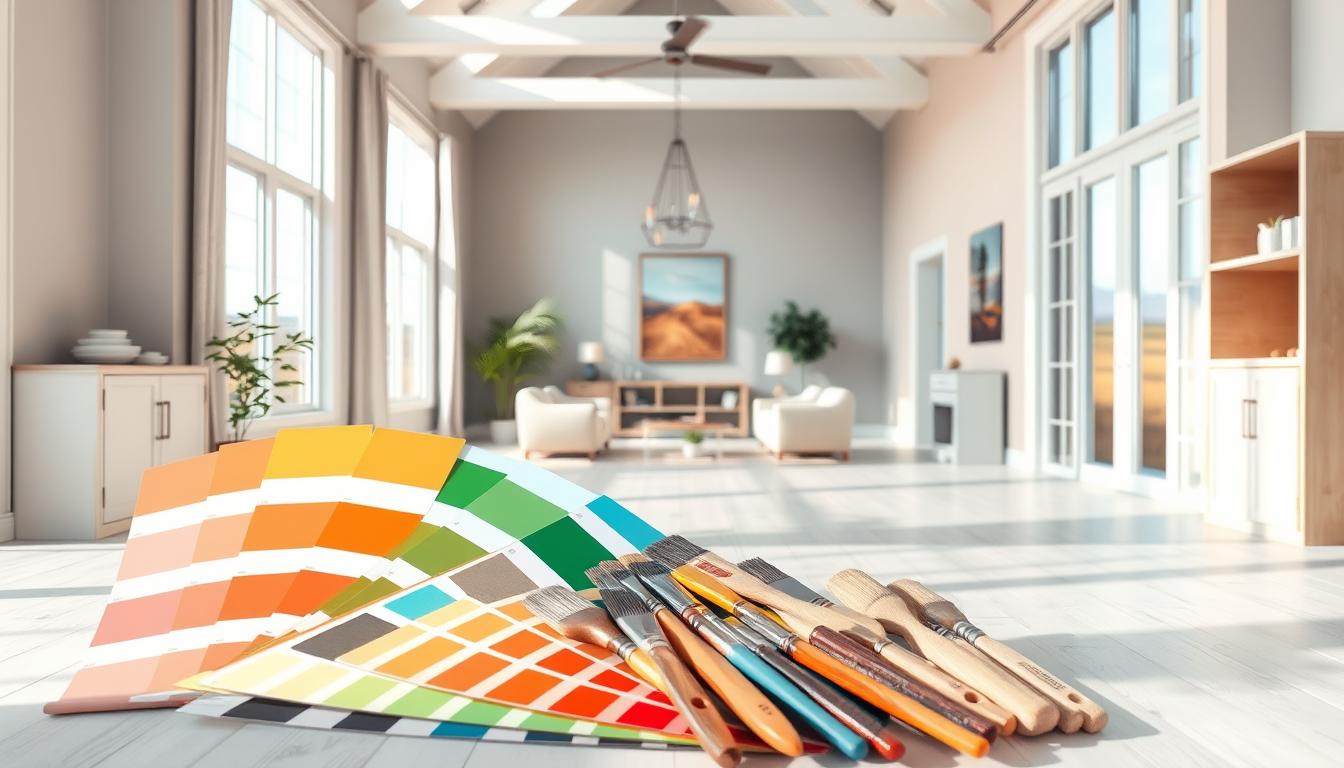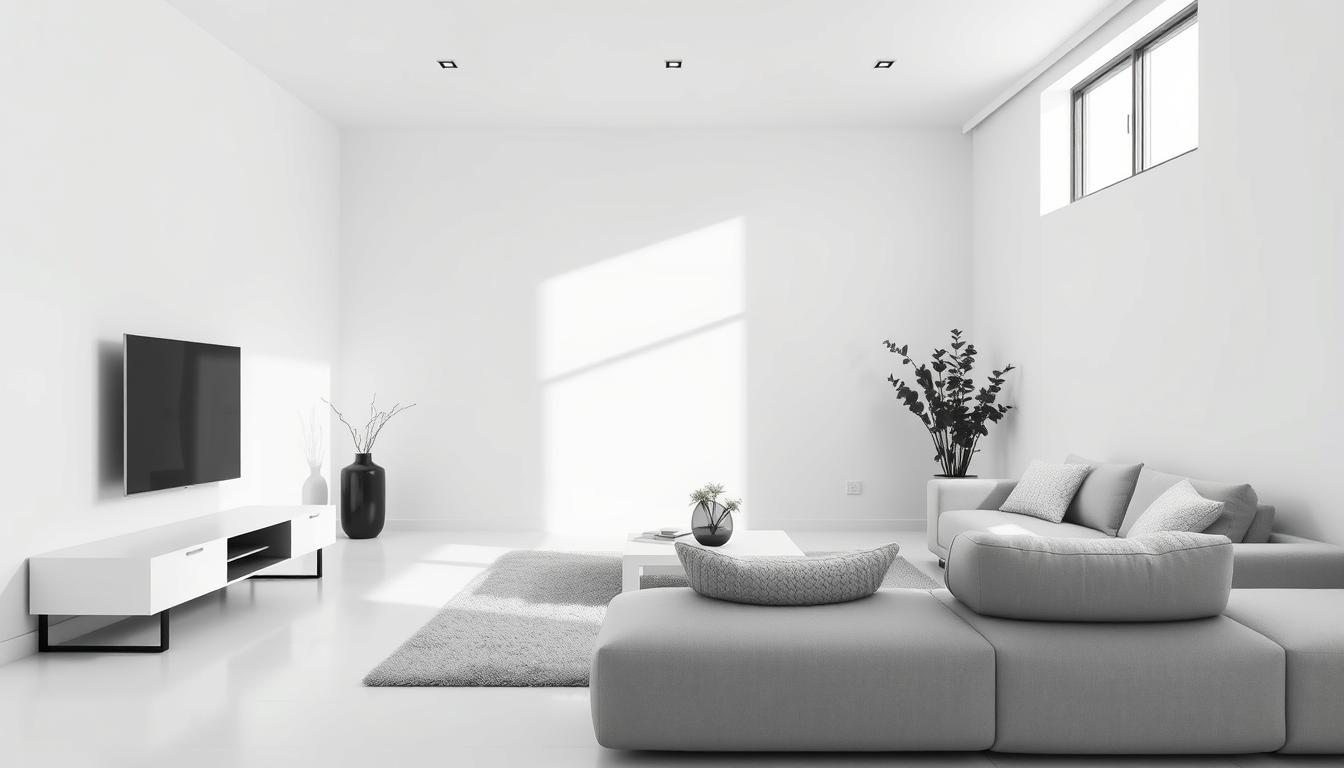The Roaring Twenties were a time of big changes in culture and society. Vintage home decor from then is still loved today. It mixes luxury with a modern feel.
Looking into historic home design, we see the 1920s as a key decade. It brought new design ideas and methods. We’ll show you how to decorate your home in the style of the 1920s. We’ll focus on the era’s key features and colors.
Key Takeaways
- Understanding the key characteristics of 1920s decor
- Exploring popular color palettes of the era
- Learning how to incorporate vintage elements into your design
- Discovering how to balance opulence with modernity
- Creating an authentic and stylish space
Understanding the Aesthetic of 1920s Home Interiors
The 1920s home interiors were a blend of Art Deco and other styles. This era saw big changes in culture and interior design. New materials and techniques changed how homes were decorated.
Key Characteristics
The 1920s interiors were known for geometric patterns and metallic accents. These added luxury and modernity. Bold shapes and metallics made homes look opulent.
Here’s a table showing the key features of 1920s interiors:
| Characteristic | Description | Examples |
|---|---|---|
| Geometric Patterns | Use of geometric shapes in decor and furniture | Chevrons, Zigzags, Hexagons |
| Metallic Accents | Incorporation of metallic materials for a luxurious feel | Chrome, Silver, Brass |
| Bold Colors | Use of vibrant and bold color schemes | Emerald Green, Navy Blue, Ruby Red |
Popular Color Palettes
The 1920s had many color palettes, from bold to subtle. Art Deco style used bold colors. But, there were also more elegant palettes for a sophisticated look.
Notable Design Movements
The 1920s were key for design movements like Art Deco. Art Deco’s glamour influenced furniture, architecture, and more. Other styles, like Mission Style and Arts & Crafts, also shaped the decade’s design.
Iconic Furniture Styles from the 1920s
The 1920s was a big change for furniture design. New styles emerged that still shape our homes today. This time saw furniture design, making, and use change a lot.
Art Deco Influences
Art Deco changed furniture design in the 1920s. It brought a glamorous look that celebrated modern life and luxury. Art Deco furniture had geometric shapes, metallics, and bright colors.
It also had detailed craftsmanship and exotic designs. Art Deco style became a symbol of the era’s sophistication and modernity. It became a favorite in many homes.
Art Deco was more than looks; it was a cultural shift. It celebrated the modern and the luxurious. Today, Art Deco furniture is highly valued by collectors and fans of antique furniture.
Mission and Arts & Crafts Styles
While Art Deco grew, Mission and Arts & Crafts styles were still loved. These styles valued handcrafted quality and simplicity. Mission style had clean lines and little decoration. Arts & Crafts focused on handmade details.
These styles showed the era’s varied tastes. They showed a balance between traditional craftsmanship and new manufacturing methods.
The Rise of Modernism
The 1920s also saw Modernism in furniture design start. This movement aimed to move away from old forms. It favored a more functional and simple look.
Modernist designers used new materials and tech. They made innovative, streamlined pieces that were both useful and lovely.
This move towards Modernism set the stage for future furniture design. It influenced many designers and shaped modern furniture.
Choosing the Right Fabrics and Textiles
Fabrics and textiles in 1920s interiors were more than just practical. They were a way to show off style and class. The right fabric can make a room feel truly from the 1920s. We’ll look at the fabrics, textures, and patterns that were popular back then.
Common Fabrics of the Era
The 1920s loved luxurious fabrics like velvet, silk, and linen. Velvet was a favorite for its soft, plush feel, used for furniture and drapes. Silk and linen were chosen for their strength and elegant look, often in window treatments and furniture.
Textures and Patterns
Fabrics’ textures and patterns were key in 1920s design. Geometric shapes, Art Deco motifs, and detailed floral designs were big. Mixing different textures, like smooth silk with velvet, made rooms more interesting.
Tips for Modern Adaptation
To add 1920s flair to today’s homes, mix old and new. Use vintage home decor fabrics for things like throw pillows or wall art. This adds a touch of the past without overdoing it. Also, picking fabrics with retro home furnishings patterns can give your space a 1920s feel.
Choosing fabrics that remind you of the 1920s can make your home feel rich and stylish. It’s a way to bring history into your space, combining old charm with today’s comfort.
Decorative Elements to Consider
The 1920s were a time of great change and creativity in interior design. Decorative elements played a crucial role in defining the aesthetic of homes during this era. We’ll explore the most significant decorative elements that can help you achieve an authentic 1920s look in your home.
Statement Lighting Fixtures
Lighting fixtures in the 1920s were not just functional; they were also decorative pieces that added to the overall ambiance of a room. Art Deco influences were prevalent, with geometric shapes and metallic materials being used extensively. Consider incorporating chandeliers or sconces with intricate designs to add a touch of glamour to your space.
As F. Scott Fitzgerald once said, “The rich gleam of the mahogany dresser, the intricate patterns of the rug, all seemed to whisper secrets of the past.” This quote captures the essence of 1920s decor, where every element, including lighting, contributed to the overall opulence.
Wall Treatments and Wallpaper
Wall treatments and wallpaper were essential in 1920s interiors, often featuring bold patterns and designs. Geometric patterns and floral motifs were popular. To recreate this look, consider using wallpaper with bold, geometric patterns or opt for a more subtle approach with textured wall coverings.
- Geometric patterns
- Floral motifs
- Textured wall coverings
Accessories that Define the Era
Accessories can make or break the authenticity of your 1920s-inspired home. Look for pieces that reflect the era’s love for antique furniture and Gatsby-era interiors. Vintage items such as vintage clocks, antique vases, and classic literature can add a touch of authenticity to your space.
“The 1920s was an era of dramatic change, not just in fashion and culture, but also in home decor. Incorporating elements from this time can add a level of sophistication and glamour to your home.”
By incorporating these decorative elements, you can create a home that truly captures the spirit of the 1920s. Whether you’re drawn to the glamour of Art Deco or the elegance of antique furniture, there’s something for everyone in this iconic era of design.
Color Schemes That Capture the 1920s Spirit
To bring the 1920s vibe into your home, you need to think about colors. The era had a mix of soft and bold colors. These colors helped shape the look of homes back then.
Muted vs. Bold Palette Choices
The 1920s had a wide range of colors. You could choose soft, muted tones or bold, eye-catching colors. Soft colors like earth tones and pastels made rooms feel cozy. Bold colors like emerald green and ruby red added luxury and excitement.
Choosing between soft and bold colors depends on what you want your space to feel like. Soft colors offer a classic, elegant look. Bold colors bring depth and personality to a room.
Key Considerations:
- The overall aesthetic you wish to achieve
- The role of furniture and decor in your color scheme
- The impact of natural light on your color choices
Integrating Metallics and Neutrals
Metallics and neutrals were key in 1920s decor. They added glamour and depth. Metallics like gold and silver were used in lighting and decor. Neutrals like beige and cream were the base for adding bold colors and patterns.
To add metallics and neutrals to your home, follow these tips:
| Element | 1920s Characteristics | Modern Adaptation |
|---|---|---|
| Metallics | Gold, silver, and copper accents in lighting and decor | Use metallic finishes in lighting fixtures and hardware |
| Neutrals | Beiges, taupes, and creams as primary color palette | Apply neutral tones to walls and larger furniture pieces |
Accent Colors for 1920s Vibe
Accent colors are key to capturing the 1920s vibe. They add color and personality. Popular colors included jewel tones and vibrant yellows. These were used in small items like throw pillows and rugs.
“The use of accent colors in 1920s decor was not just about adding color; it was about creating a mood and an atmosphere that reflected the era’s glamour and sophistication.”
To use accent colors well, start with a few key pieces. Choose items that reflect the 1920s style. Then, balance these bold choices with softer elements to avoid too much.
Flooring Options for a 1920s Home
The 1920s offered a wide range of flooring, from elegant hardwood to plush carpets. Each option has its own charm. Choosing the right flooring is key to keeping your 1920s home authentic.
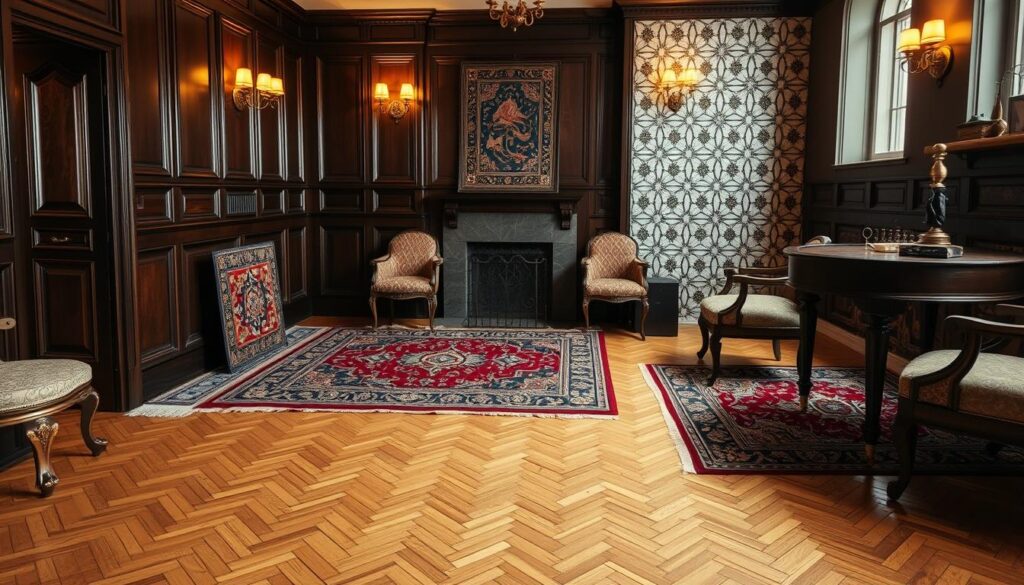
Hardwood Floors vs. Carpets
Hardwood floors were common in 1920s homes for their durability and timeless look. They can be refinished to shine like new. Carpets, on the other hand, were popular for their warmth and comfort, often in bedrooms and living areas.
The choice between hardwood and carpet depended on the room’s purpose and the desired feel.
Tiles and Stone Choices
In 1920s homes, tiles and stone were used in entryways, bathrooms, and kitchens. Ceramic tiles, marble, and other natural stones were chosen for their beauty and durability. These materials bring vintage elegance and are easy to care for.
Area Rugs that Complement
Area rugs added color, texture, and warmth to rooms in 1920s homes. They often featured traditional patterns and motifs. When picking an area rug, match the era’s designs and colors to enhance your decor.
Whether it’s an antique or a reproduction, the right rug can make a big difference in a room’s look.
Embracing Art and Decor from the Era
The 1920s was a time of luxury and elegance. It was a period of great creativity in art and design. Many famous artists and designers made their mark during this era.
Famous Artists and Designers
Iconic artists and designers emerged in the 1920s. Jean Dupas and Émile-Jacques Ruhlmann were key figures in the Art Deco movement. Their work, known for geometric shapes and metallics, still influences design today.
Wall Art and Sculptures
Wall art and sculptures were big in 1920s decor. They showed the era’s love for modern and avant-garde styles. Pieces often had geometric or floral designs, showcasing top-notch craftsmanship.
Vintage Finds and Replicas
For a true 1920s feel, vintage items and replicas are essential. You can find original pieces at antique shops or online. Or, try making replicas with vintage-inspired materials. Both options can bring a 1920s vibe to your home.
Kitchen and Bathroom Designs of the 1920s
Kitchen and bathroom designs in the 1920s changed a lot. New technologies and lifestyles led to these changes. Homes became more modern, needing better kitchen and bathroom spaces.
Functional Layouts
The 1920s brought more practical kitchen layouts. Work triangles were key, with sink, stove, and fridge forming a triangle for better workflow. Bathrooms also got more organized, with built-in storage and space-saving designs.
- Increased use of built-in cabinetry in kitchens
- Introduction of more efficient plumbing fixtures in bathrooms
- Emergence of the “work triangle” concept in kitchen design
Popular Fixtures and Appliances
The 1920s saw new appliances and fixtures in kitchens and bathrooms. Kitchens got electric refrigerators, replacing iceboxes. Bathrooms welcomed porcelain fixtures widely.
- Electric refrigerators became more common in kitchens
- Porcelain and ceramic fixtures gained popularity in bathrooms
- New materials and technologies improved durability and hygiene
Tile Invocations in Modern Spaces
Tiles were key in 1920s kitchen and bathroom designs. They added function and beauty. Glazed ceramic tiles were favorites, used for walls and floors. We can still use these in modern designs.
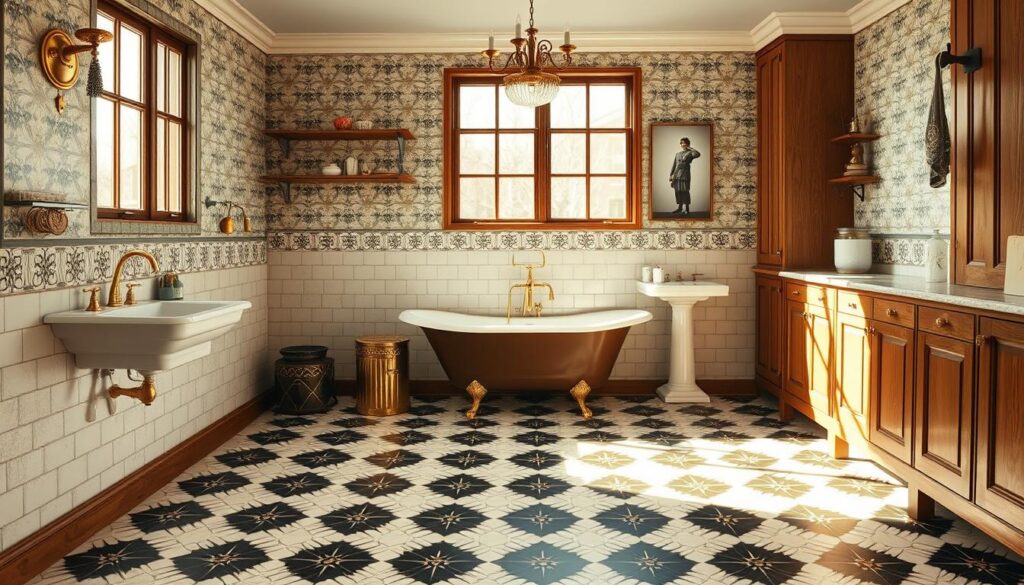
To bring 1920s style to modern kitchens and bathrooms, use vintage-style tiles and fixtures. Adding art deco patterns can also capture the era’s essence.
Planting the Seeds of Indoor Gardening
In the 1920s, homeowners brought nature inside with plants and decorative planters. This added beauty and showed their love for nature.
They chose lush greenery and flowering plants for their homes. These plants were easy to care for and looked great.
Popular Houseplants of the Era
Ferns, begonias, and African Violets were favorites in the 1920s. They were loved for their beauty and indoor growth.
- Ferns added elegance with their delicate fronds.
- Begonias were admired for their vibrant flowers and foliage.
- African Violets were cherished for their dainty, purple blooms.
Gardening experts said, “The right plant in the right pot can transform a room, bringing in a breath of fresh air and a splash of color.”
“Gardening is not just about plants; it’s about creating an atmosphere.”
Decorative Planters
Choosing the right planter was key. In the 1920s, planters ranged from ceramic to ornate metalwork. Each added its own charm to the garden.
| Planter Material | Characteristics | Popular Styles |
|---|---|---|
| Ceramic | Durable, versatile | Art Deco patterns, earth tones |
| Metalwork | Ornate, elegant | Wrought iron, brass |
| Terracotta | Natural, rustic | Plain, glazed |
Creating a Vintage-Inspired Garden
To create a vintage garden, mix traditional plants with antique planters. Add vintage tools or floral patterns for extra charm.
By following 1920s indoor gardening, you can add history to your home. It blends old charm with today’s style.
Tips for Maintaining Authenticity
To keep a 1920s home true to its era, focus on the right furniture and decor. Look for antique pieces and add vintage touches. These should reflect the art deco style of the time.
Authentic Furnishings
Getting real antiques is key to keeping your home’s 1920s charm. Search antique stores, estate sales, and online for pieces that match your style.
Vintage Touches
Adding era-specific items, like vintage lights and ornate metalwork, makes your space look cohesive. These touches help keep the art deco style alive in your home.
Balancing Comfort and Integrity
It’s important to keep your home’s history while adding modern comforts. Mix in today’s amenities in a way that honors your home’s original look. This way, your 1920s home stays stylish and practical.

